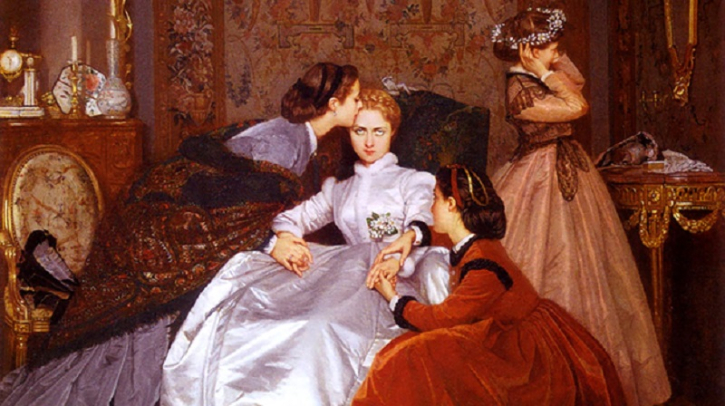
The Reluctant Bride. Toulmouche, A. (1866). Photo: Collected
In the hallowed halls of the Victorian era, where corsets were even tighter and social expectations even more rigid, a subtle rebellion simmered beneath the surface. Empowering female characters who had defied social norms and expressed a fierce feminine rage towards the constraints of their time have emerged in such literary works.
The Victorian era, ranging from 1837 to 1901 has greatly impacted the literary works we now know of today. Victorian culture was defined by a system of strict and distinct domains and conventional norms, women had to stay at home while men participated in public life. Expectedly, some women were unhappy with this inflexible separation, which fed their desire for more important positions and chances.
In Louisa May Alcott's "Little Women," the March sisters are more than just charming; they symbolize a strong rebellion hidden behind innocent, curious young girls. Jo, the strong lead character, aspires to literary fame, which is unthinkable for a young woman in her generation. Because it reveals the hidden desire for artistic fulfillment and self-expression beneath the surface of Victorian society, readers can still relate to her fierce defiance and refusal to fit the stereotype of a dainty daughter.
However, “Little Women” was not the only phenomenon. Mary Wollstonecraft Shelley’s “Frankenstein” explores the Gothic denial of female autonomy. The rejection and scorn by a society upholding inflexibility in norms experienced by the women reflect the loneliness and longing for recognition and acceptance felt by the creature, even though it would be ostracized in its attempt at reaching out. The search for understanding ends up as a horrifying prophecy on coming female torments that stem from cultural bias.
On the other hand, “Cranford” by Elizabeth Gaskell illustrates how women had to go through life struggles alone, without any support from men. The women of Cranford live without husbands and fathers making it a hard yet ingenious place they create for themselves in the seeming mundane activities of gossip and tea. Mrs. Jamieson is unflinchingly courageous and heads the community. Her tongue is just as sharp as its wit and her loyalty as steel-tempered. Miss Matty Jenkyns becomes less fearful of managing her finances and as a result, her anxiety becomes quite forceful. These little revolts are part of everyday life, they manifest that women's unions remain possible even under harsh conditions.
“Middlemarch” tells the story of Dorothea Brooke, a girl in search of a combination of intellectual and religious satisfaction. Nonetheless, her dreams are entangled by a loveless marriage and social expectations. Unlike a frenzied act of uprising, Dorothea’s story is that of tranquil refusal. Her unyielding commitment to her principles and tireless quest for knowledge serve as gentle rebuttals of patriarchal attitudes. It makes people realize how various efforts to be free are presented in society, especially minor rebellions that may mean a lot for their results.
Such literary expressions of rebellion addressed the aspirations and disappointments of real-life women, rather than being mere fairytales. Poems written by Victorian writers such as Christina Rossetti and Elizabeth Barrett Browning were filled with vicious verses that questioned Victorian femininity ideals and served as cries for female agency. While the Brontë sisters were hardly noticed when alive, they paved the way for future women’s novelists and their books became a guiding light and an escape from the norm for those wanting to find another way.
With the power of ink, these women had exchanges of powerful words, a hushed conversation resonating in drawing rooms and libraries alike. They fueled the dreams of people who thought their lives could be better and gave solace to those who suffered because of societal demands. However, their contributions helped lay the foundation of gender equality, although they did not identify as feminists.
As one would have expected, there were twists and turns in the journey. Victorian literature exemplified this fear regarding social change and aversion. There were male writers whose opinions were anti-feminist, who wrote anti-feminine texts during these years; many contemporary female writers still contended with the restrictions of the publishing industry and society's frowns.
However, it is important to note that no seed goes unharvested. Women’s Suffrage Movement is associated with subtle disobediences that developed into a song leading to suffrage. The echoes of such Victorian voices are still audible in our day, reminding us that the fight for women’s emancipation is an ongoing affair, and there cannot be any small gestures of rebellion if the world we desire is more fair and equal.
This defiance was not just a tantrum of throwing things around; it was a controlled fire, a wild determination to forge one’s way forward. Books were their ambrosia and every leaf was a log thrown into their burning hell. Raw and Unrestrained, they wrote whatever came to their minds as they put their dreams on paper and their frustrations by building imaginary worlds where women were not bound to the drawing room, went up mountains and sailed uncharted water.
It was surely not an ordinary revolt but a display of anger by women who wanted to be set free but could not due to control and subjugation into slavery by society. These female writers had a wind that made a storm with every dash or world they painted in their imaginations. Underneath their words was seething anger which sounded more like an explosion ready to detonate on demand for independence, and respect, and to demolish the paternal system designed to incarcerate them.
In our contemporary days, as we struggle with perennial injustices and societal requirements, the heritage of these writers during the Victorian era is a testimony that no single gesture however subdued can cause earthquakes. The storyline was their model of a better, moral society.
The Symphony of Rebellion by the literary pioneers still plays, inviting us to listen, study, and carry on their legacy. Driven by a rage that could only be defined as female, the flames they ignited have never stopped burning and are light into the long journey to women’s rights. As long as we find ourselves inspired by theirs, it is our responsibility to add our own verses so that there will be resistance voices echoing for centuries to come. In the continuing story of the development, the stain of rebellion continues as a permanent imprint, a proof of the strength of pen on the fate of nations and the destinies of those who aspire for a new, fairer society.
The writer is student of Grade 12, Canadian International Institute, Dhaka.

.png)







